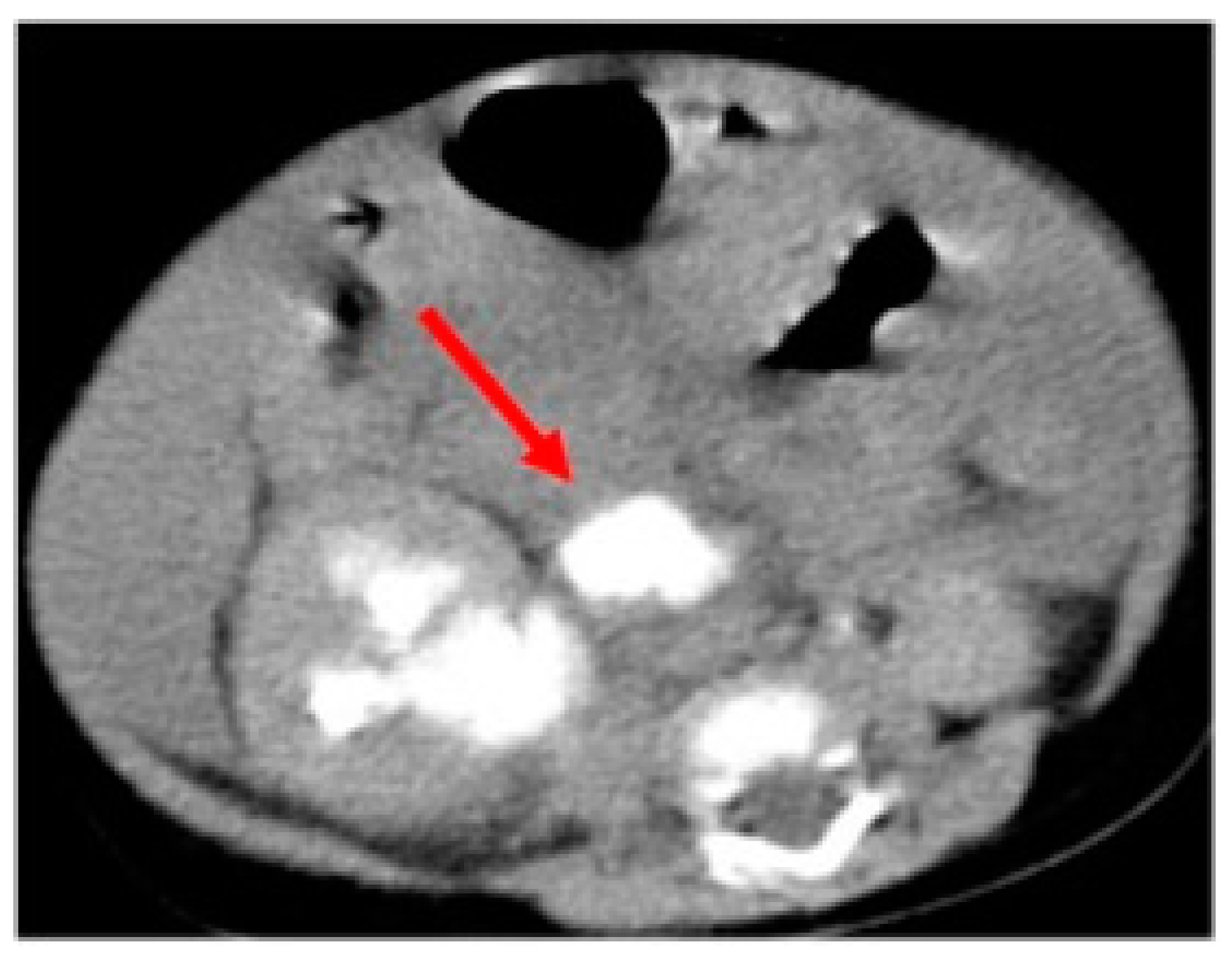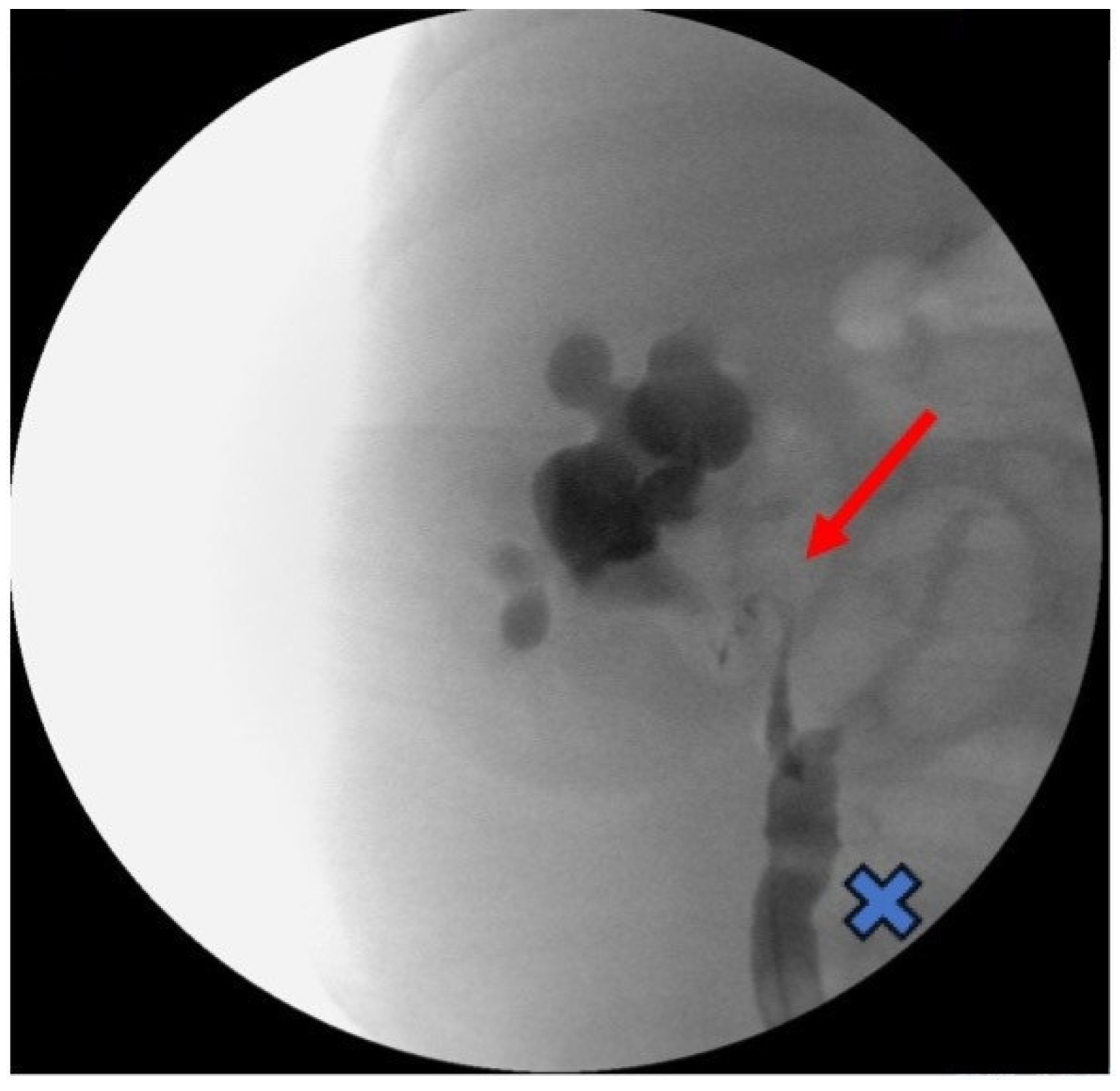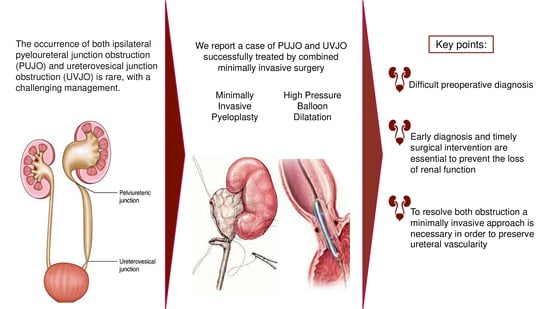Combined Minimally Invasive Treatment of Pyeloureteral Junction Obstruction and Primary Obstructive Megaureter in Children: Case Report and Literature Review
Abstract
1. Introduction
2. Case Report
3. Discussion
4. Conclusions
Author Contributions
Funding
Institutional Review Board Statement
Informed Consent Statement
Data Availability Statement
Conflicts of Interest
References
- Bailey, R.R.; Lynn, K.L.; Robson, R.A. End-stage reflux nephropathy. Ren. Fail. 1994, 16, 27–35. [Google Scholar] [CrossRef] [PubMed]
- Yosypiv, I.V. Congenital anomalies of the kidney and urinary tract: A genetic disorder? Int. J. Nephrol. 2012, 2012, 909083. [Google Scholar] [CrossRef] [PubMed]
- Avanoglu, A.; Tiryaki, S. Embryology and Morphological (Mal)Development of UPJ. Front. Pediatr. 2020, 8, 137. [Google Scholar] [CrossRef] [PubMed]
- Gimpel, C.; Masioniene, L.; Djakovic, N.; Schenk, J.P.; Haberkorn, U.; Tönshoff, B.; Schaefer, F. Complications and long-term outcome of primary obstructive megaureter in childhood. Pediatr. Nephrol. 2010, 25, 1679–1686. [Google Scholar] [CrossRef] [PubMed]
- Kumar, S.; Khanna, A.; Parmar, K.M. Robot-Assisted Simultaneous Pyeloplasty and Ureteric Reimplantation for Unilateral Double Obstruction of the Ureter: Technical feasibility, Tips and Tricks. Urology 2020, 139, 118–121. [Google Scholar] [CrossRef]
- Babu, R.; Vittalraj, P.; Sundaram, S.; Shalini, S. Pathological changes in ureterovesical and ureteropelvic junction obstruction explained by fetal ureter histology. J. Pediatr. Urol. 2019, 15, 240.e1–240.e7. [Google Scholar] [CrossRef] [PubMed]
- Nie, X.; Sun, J.; Gordon, R.E.; Cai, C.L.; Xu, P.X. SIX1 actssynergistically with TBX18 in mediating ureteral smooth muscleformation. Development 2010, 137, 755–76548. [Google Scholar] [CrossRef]
- Song, R.; Yosypiv, I.V. Genetics of congenital anomalies of the kidney and urinary tract. Pediatr. Nephrol. 2011, 26, 353–364. [Google Scholar] [CrossRef] [PubMed]
- Zhou, Y.; Wang, X. Renal rupture in neonate with severe hydronephrosis. Asian J. Surg. 2022, 45, 1724–1725. [Google Scholar] [CrossRef]
- Chang, C.J.; Yeh, M.L.; Chen, C.C. Rhabdoid tumor of the kidney with spontaneous rupture: Case report and review of literature. Pediatr. Surg. Int. 2008, 24, 451–453. [Google Scholar] [CrossRef]
- Prat, E.; Seo-Mayer, P.; Agarwal, S. Neonate with urinary ascites but no hydronephrosis: Unusual presentation of posterior urethral valves. BMJ Case Rep. 2018, 2018, bcr2018225053. [Google Scholar] [CrossRef] [PubMed]
- Hunley, T.E.; Adams, M.C.; Hernanz-Schulman, M.; Jabs, K. A critically ill newborn with a distended abdomen. Kidney Int. 2017, 92, 521. [Google Scholar] [CrossRef] [PubMed]
- Mc Grath, M.A.; Estroff, J.; Lebowitz, R.L. The coexistence of obstruction at the ureteropelvic and ureterovesical junctions. Am. J. Roentgenol. 1987, 149, 403–406. [Google Scholar] [CrossRef]
- Pesce, C.; Musi, L.; Campobasso, P.; Costa, L.; Fabbro, M. Coexisting pelviureteral and vesicoureteral junction obstruction in children. Eur. J. Pediatr. Surg. 2003, 13, 367–371. [Google Scholar] [CrossRef] [PubMed]
- Cay, A.; Imamoglu, M.; Bahat, E.; Sarihan, H. Diagnostic difficulties in children with coexisting pelvi-ureteric and vesico-ureteric junction obstruction. BJU Int. 2006, 98, 177–182. [Google Scholar] [CrossRef] [PubMed]
- Moodley, P.; Demaria, J.; Lorenzo, A.J.; Pippi Salle, J.L.; Braga, L.H. Concurrent ureteropelvic and ureterovesical junction obstruction in children: The value of retrograde pyelography. J. Pediatr. Urol. 2010, 6, 117–121. [Google Scholar] [CrossRef]
- Neulander, E.Z.; Katz, T.; Kaneti, J. Upper pole multicystic dysplasia and ureteropelvic junction obstruction associated with obstructive-refluxing megaureter in a neonate with a single kidney. Can. J. Urol. 2010, 17, 5472–5474. [Google Scholar] [PubMed]
- Ebadi, M.; Kajbafzadeh, A.M.; Tourchi, A.; Mousavian, A.A. Endoureterotomy as the initial management of concurrent ureteropelvic and ureterovesical junction obstruction after failed conservative therapy. Urology 2013, 82, 214–219. [Google Scholar] [CrossRef]
- Lee, Y.S.; Im, Y.J.; Lee, H.; Kim, M.J.; Lee, M.J.; Jung, H.J.; Han, S.W. Coexisting ureteropelvic junction obstruction and ureterovesical junction obstruction: Is pyeloplasty always the preferred initial surgery? Urology 2014, 83, 443–449. [Google Scholar] [CrossRef]
- Sharma, N.; Bajpai, M.; Panda, S.S. Pelviureteric Junction Obstruction Associated with Vesico-ureteric reflux and Vesico-ureteric Junction Obstruction: Challenges and Management Protocols. J. Prog. Paediatr. Urol. 2014, 17, 24–27. [Google Scholar]
- Reich, D.A.; Bayne, C.E.; Sharadin, C.A.; DeMarco, R.T. Bilateral proximal ureteral and ureterovesical junction obstruction in a child. Urol. Case Rep. 2023, 50, 102472. [Google Scholar] [CrossRef]
- Li, Z.; Yang, K.; Li, X.; Chen, S.; Wang, X.; Li, Z.; Li, X. Minimally invasive ureteral reimplantation or endoscopic management for primary obstructive megaureter: A narrative review of technical modifications and clinical outcomes. Transl. Androl. Urol. 2022, 11, 1786–1797. [Google Scholar] [CrossRef]
- Isac, G.V.; Danila, G.M.; Ionescu, S.N. Spontaneous resolution and the role of endoscopic surgery in the treatment of primary obstructive megaureter: A review of the literature. Pediatr. Med. Chir. 2023, 45. [Google Scholar] [CrossRef]
- Torino, G.; Roberti, A.; Brandigi, E.; Turrà, F.; Fonzone, A.; Di Iorio, G. High-pressure balloon dilatation for the treatment of primary obstructive megaureter: Is it the first line of treatment in children and infants? Swiss. Med. Wkly. 2021, 151, w20513. [Google Scholar] [CrossRef]
- Cobellis, G.; Nino, F.; Pierangeli, F.; Mariscoli, F.; Noviello, C.; Martino, A. Retroperitoneoscopic One-Trocar-Assisted Pyeloplasty in Children: An Age-Related Evaluation. J. Laparoendosc. Adv. Surg. Tech. A 2017, 27, 651–654. [Google Scholar] [CrossRef]





| Article | Demographics | First Diagnosis | First Surgery | Second Diagnosis | Second Surgery | ||||||||||||
|---|---|---|---|---|---|---|---|---|---|---|---|---|---|---|---|---|---|
| Author | Years | Country | Patients N° | Sex (M: Male, F: Female) | Age | Side (L: Left, R: Right, B: Bilateral) | PUJO | UVJO | PUJO + UVJO | Procedure | Others | PUJO | UVJO | Procedure | Others | ||
| During Surgery | During Follow-Up | During Surgery | During Follow-Up | ||||||||||||||
| McGrath | 1987 | USA | 14 | 7 M, 7 F | 0–11 years | 11L, 3R | 5 | 6 | 3 | Pyeloplasty (5), ureteral reimplantation (6), and simultaneous operation (2) | Follow-up for both obstructions (1) | 6 | 5 | Reimplantation (2) and pyeloplasty (6) | Follow-up (3) | ||
| Pesce | 2003 | Italy | 11 | 7M, 4 F | 0–8 years | n/a | 6 | / | 5 | 11 pyeloplasty | / | / | 3 | 3 | Reimplantation (6) | ||
| Cay | 2006 | Turkey | 14 | 10 M, 4 F | 2–54 months | 9L, 5R | 9 | / | 5 | 14 pyeloplasty | / | / | 6 | 3 | Reimplantation (4) | Follow-up (1) | |
| Moodley | 2010 | Canada | 2 | 1 M, 1 F | 0–6 weeks | 1L, 1R | 2 | / | / | 2 pyeloplasty | Cold knife ureterocele incision (2) | / | / | 2 | |||
| Neulander | 2010 | Israel | 1 | 1 M | 20 days | 1L | / | / | 1 | Percutaneous drainage and later on upper pole partial nephrectomy and pyeloplasty with a modified Y urethrotomy | / | / | / | / | Reimplantation (1) | ||
| Ebadi | 2013 | Iran | 47 | 19 M 28 F | n/a | 27R, 20L | / | / | 47 | Endoureterotomy (47) (VUJO) | 39/47 successful for both obstructions | / | / | / | / | Second attempt of endoureterotomy (8) | Resolution of both obstructions (3), ureteral reimplantation (2), reimplantation + mini-pyeloplasty (1), and mini-pyeloplasty (2) |
| Lee | 2014 | Korea | 15 | n/a | n/a | n/a | 4 | 1 | 10 | Pyeloplasty (9), ureteroneocystostomy with Starr plications (5), both procedures (1) | 1 | 4 | Ureteroneocystostomy (2) and pyeloplasty (2) | ||||
| Sharma | 2014 | India | 4 | n/a | n/a | n/a | 2 | / | 2 | Pyeloplasty (4) | / | / | 2 | Reimplantation (4) | |||
| Kumar | 2020 | India | 1 | F | 16 years | L | / | / | 1 | Robotic pyeloplasty and reimplantation | / | / | / | / | |||
| Reich | 2023 | USA | 1 | F | 11 months | B | / | 1 | / | Bilateral Politano-leadbetter ureteral reimplantation | Nephrostomy left in place | 1 | / | / | L pyeloplasty, R pyeloplasty (1 month later) | ||
Disclaimer/Publisher’s Note: The statements, opinions and data contained in all publications are solely those of the individual author(s) and contributor(s) and not of MDPI and/or the editor(s). MDPI and/or the editor(s) disclaim responsibility for any injury to people or property resulting from any ideas, methods, instructions or products referred to in the content. |
© 2024 by the authors. Licensee MDPI, Basel, Switzerland. This article is an open access article distributed under the terms and conditions of the Creative Commons Attribution (CC BY) license (https://creativecommons.org/licenses/by/4.0/).
Share and Cite
Di Fabrizio, D.; Tavolario, I.; Rossi, L.; Nino, F.; Bindi, E.; Cobellis, G. Combined Minimally Invasive Treatment of Pyeloureteral Junction Obstruction and Primary Obstructive Megaureter in Children: Case Report and Literature Review. Children 2024, 11, 407. https://doi.org/10.3390/children11040407
Di Fabrizio D, Tavolario I, Rossi L, Nino F, Bindi E, Cobellis G. Combined Minimally Invasive Treatment of Pyeloureteral Junction Obstruction and Primary Obstructive Megaureter in Children: Case Report and Literature Review. Children. 2024; 11(4):407. https://doi.org/10.3390/children11040407
Chicago/Turabian StyleDi Fabrizio, Donatella, Irene Tavolario, Lorenzo Rossi, Fabiano Nino, Edoardo Bindi, and Giovanni Cobellis. 2024. "Combined Minimally Invasive Treatment of Pyeloureteral Junction Obstruction and Primary Obstructive Megaureter in Children: Case Report and Literature Review" Children 11, no. 4: 407. https://doi.org/10.3390/children11040407
APA StyleDi Fabrizio, D., Tavolario, I., Rossi, L., Nino, F., Bindi, E., & Cobellis, G. (2024). Combined Minimally Invasive Treatment of Pyeloureteral Junction Obstruction and Primary Obstructive Megaureter in Children: Case Report and Literature Review. Children, 11(4), 407. https://doi.org/10.3390/children11040407







